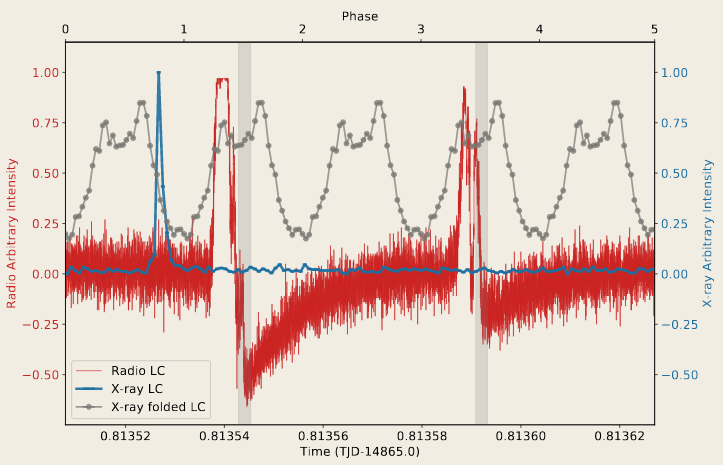
Magnetars, neutrons stars (NS) powered by their own magnetic energy, host the strongest magnetic fields in the present Universe. This make them unique laboratories to test physical theories in the strong field regime.
The current census of the neutron star (NS) population includes about 30 magnetars: isolated NSs endowed with an ultra-strong magnetic field (B∼1013-1015 Gauss) whose dissipation is thought to provide the ultimate driver for their emission. Magnetars show a rich phenomenology of high-energy transient episodes, such as very energetic and rare giant flares (∼1046 erg s-1 released on timescales of several minutes), short X-ray bursts(∼1040 erg s-1 released in less than a second), and large outbursts where the source steady X-ray luminosity (LX∼1031-35 erg s-1) increases by several orders of magnitude and usually recovers the quiescent state on a timescale varying from months to several years (Magnetar Outburst Online Catalog). Other kinds of pulsars have shown magnetar-like activity, e.g. two rotation-powered pulsars, the so-called low-field magnetars (seemingly normal magnetars but having dipolar magnetic fields of ≤1013 Gauss), and the central compact object (CCO) in the supernova remnant (SNR) RCW 103 [1] . Furthermore, during the recent X-ray outburst of a known magnetar, SGR 1935+2154, the radio counterpart to a short X-ray burst was discovered, crucial evidence of the connection between magnetar flares and Fast Radio Bursts (FRBs). These discoveries show that magnetar-like activity is very common among Galactic NSs, and possibly related to the most extreme transient events observed in our and other galaxies (as FRBs, SL-SNe, long GRBs, etc). Based on this result other similar events have been searched in simultaneous X-ray and radio observations and have been found in 1E547.0-5408 (Figure above; [2]).
Our group is deeply involved in the study of magnetars since the very beginning when we discovered pulsation from one of the prototype sources of the class, 4U0142+614; [3]). Since then we discovered and studied several new members of the class owing to dedicated programs on several multi-wavelength facilities (such as XMM, Chandra, Swift, Parkes, GBT, etc.).
Studies are mainly focused on the discovery, follow-up/monitoring and studies of magnetars by means of a multiwavelength approach [4,5,6]. In particular, timing and spectral analysis in the X-ray band (and radio when available) play an important role in assessing the main properties of the NS, such as the magnetic field strength, its characteristic age, the distance, etc. [7,8]
If you are interested in a thesis regarding magnetars here you can find available theses about this topic.
Involved group members: Gianluca Israel, Matteo Imbrogno, Luigi Stella
References
[1] Rea, N., A. Borghese, P. Esposito, F. Coti Zelati, M. Bachetti, G. L. Israel, and A. De Luca , 2016, The Astrophysical Journal, 828, L13, "Magnetar-like Activity from the Central Compact Object in the SNR RCW103"
[2] Israel, G. L., M. Burgay, N. Rea, P. Esposito, A. Possenti, S. Dall'Osso, L. Stella, M. Pilia, A. Tiengo, A. Ridnaia, A. Y. Lien, D. D. Frederiks, and F. Bernardini, 2021 The Astrophysical Journal, 907, 7, "X-Ray and Radio Bursts from the Magnetar 1E 1547.0-5408"
[3] Israel, G. L., S. Mereghetti, and L. Stella, 1994 The Astrophysical Journal, 433, L25, "The Discovery of 8.7 Second Pulsations from the Ultrasoft X-Ray Source 4U 0142+61"
[4] Pennucci, T. T., A. Possenti, P. Esposito, N. Rea, D. Haggard, F. K. Baganoff, M. Burgay, F. Coti Zelati, G. L. Israel, and A. Minter, 2015 The Astrophysical Journal, 808, 81, "Simultaneous Multi-band Radio and X-Ray Observations of the Galactic Center Magnetar SGR 1745-2900"
[5] Israel, G. L., P. Esposito, N. Rea, F. Coti Zelati, A. Tiengo, S. Campana, S. Mereghetti, G. A. Rodriguez Castillo, D. Götz, M. Burgay, A. Possenti, S. Zane, R. Turolla, R. Perna, G. Cannizzaro, and J. Pons , 2016, Monthly Notices of the Royal Astronomical Society, 457, 3448, "The discovery, monitoring and environment of SGR J1935+2154"
[6] Coti Zelati, F., A. Borghese, G. L. Israel, N. Rea, P. Esposito, M. Pilia, M. Burgay, A. Possenti, A. Corongiu, A. Ridolfi, C. Dehman, D. Viganò, R. Turolla, S. Zane, A. Tiengo, and E. F. Keane , 2021, The Astrophysical Journal, 907, L34, "The New Magnetar SGR J1830-0645 in Outburst"
[7 ] Kozlova, A. V., G. L. Israel, D. S. Svinkin, D. D. Frederiks, V. D. Pal'shin, A. E. Tsvetkova, K. Hurley, J. Goldsten, D. V. Golovin, I. G. Mitrofanov, and X.-L. Zhang, 2016 Monthly Notices of the Royal Astronomical Society, 460, 2008, "The first observation of an intermediate flare from SGR 1935+2154"
[8] Rodríguez Castillo, G. A., G. L. Israel, P. Esposito, J. A. Pons, N. Rea, R. Turolla, D. Viganò, and S. Zane , 2014, Monthly Notices of the Royal Astronomical Society, 441, 1305, "Pulse phase-coherent timing and spectroscopy of CXOU J164710.2-45521 outbursts"